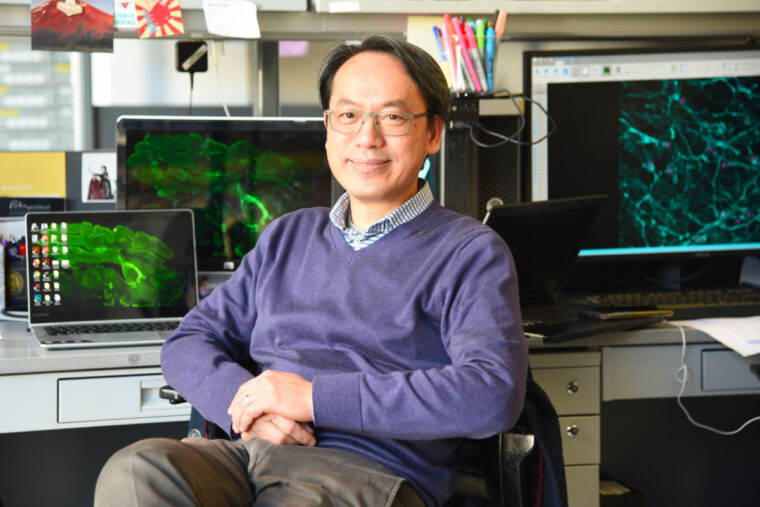
Eric J. Huang, MD, PhD, a renowned physician-scientist specializing in neurodevelopmental and neurodegenerative diseases, has been named the Edward Mallinckrodt Professor and head of the Department of Pathology & Immunology at Washington University School of Medicine in St. Louis. His appointment begins Jan. 1.
Huang comes to WashU Medicine from the University of California, San Francisco (UCSF), where he is a professor and vice chair of research for the Department of Pathology. His appointment was announced by David H. Perlmutter, MD, executive vice chancellor for medical affairs, the George and Carol Bauer Dean of the School of Medicine, and the Spencer T. and Ann W. Olin Distinguished Professor.
"We are so fortunate to have Dr. Huang, an exceptionally talented physician-scientist, join our leadership team and the WashU Medicine community," Perlmutter said. "With his leadership and expertise, we see enormous potential to advance the clinical practice and science in anatomic pathology, laboratory medicine and immunology with revolutions in imaging technologies and by applying artificial intelligence and the precision medicine paradigm to our efforts, which altogether will enhance our long-standing legacy as one of the most - if not the most - accomplished faculties in pathological and immunological sciences."
Trained as a developmental biologist, Huang has made seminal discoveries in unraveling the complexities of human brain development. His laboratory focuses on understanding the processes involved in how the brain develops in utero and in infancy. In recent studies, he has identified how the human brain continuously produces specialized cells - GABAergic interneurons - during the prenatal period and then incorporates them into brain networks during infancy. His studies also have revealed how blood vessel cells develop in the prenatal human brain and how misguided immune cells increase the risk of brain hemorrhage in premature infants, helping to pave the way for future therapeutics to stop brain bleeds in preterm infants.
Huang's research also focuses on understanding the drivers of frontotemporal dementia, the second most common cause of dementia in people under age 65. Work from his laboratory uncovered that over-reactive microglia - immune cells responsible for protecting the brain from infection and disposing of dead cells - promote excessive pruning of brain cell connections. He also found that such cells work with other brain cells called astrocytes to cause the damage to and loss of neurons implicated in frontotemporal dementia.
His research is funded by six major grants from the National Institutes of Health (NIH).
"It is an honor to join WashU Medicine in this role," Huang said. "I am excited by the opportunity to build upon the strengths of a department that is leading the field in clinical innovation and research. WashU Medicine has a strong collaborative culture, which I aim to continue fostering within the department and with other disciplines. I am eager to support early-career faculty in becoming independent investigators and advancing our commitment to the success of trainees."
Huang's research has been published in top-tier journals, including Science, Nature and Cell, among others. His scientific accomplishments also have been recognized throughout his career. As a junior faculty member, he received the Presidential Early Career Award for Scientists and Engineers. Most recently, he was elected as an academician to Academia Sinica, a leading academic institution in Taipei, Taiwan. He also is known as a dedicated mentor to PhD and MD/PhD students, postdoctoral trainees and early-career faculty.
Huang earned his medical degree from the National Taiwan University College of Medicine before completing his doctoral studies at the Weill Cornell Graduate School of Medical Sciences in New York. He completed residency training in anatomic pathology, and fellowship training in neuropathology at UCSF, where he also stayed to complete a Howard Hughes Medical Institute's postdoctoral fellowship. In 2000, he joined UCSF's faculty.
Huang will succeed Richard J. Cote, MD, who has led the department since 2019. Cote will continue his research at WashU Medicine, where he studies tumor progression and response to therapy, and as a pathologist focusing on breast and genitourinary cancer diagnoses in patients seen at Siteman Cancer Center, based at Barnes-Jewish Hospital and WashU Medicine.
About Washington University School of Medicine
WashU Medicine is a global leader in academic medicine, including biomedical research, patient care and educational programs with 2,900 faculty. Its National Institutes of Health (NIH) research funding portfolio is the second largest among U.S. medical schools and has grown 56% in the last seven years. Together with institutional investment, WashU Medicine commits well over $1 billion annually to basic and clinical research innovation and training. Its faculty practice is consistently within the top five in the country, with more than 1,900 faculty physicians practicing at 130 locations and who are also the medical staffs of Barnes-Jewish and St. Louis Children's hospitals of BJC HealthCare. WashU Medicine has a storied history in MD/PhD training, recently dedicated $100 million to scholarships and curriculum renewal for its medical students, and is home to top-notch training programs in every medical subspecialty as well as physical therapy, occupational therapy, and audiology and communications sciences.
Originally published on the School of Medicine website






